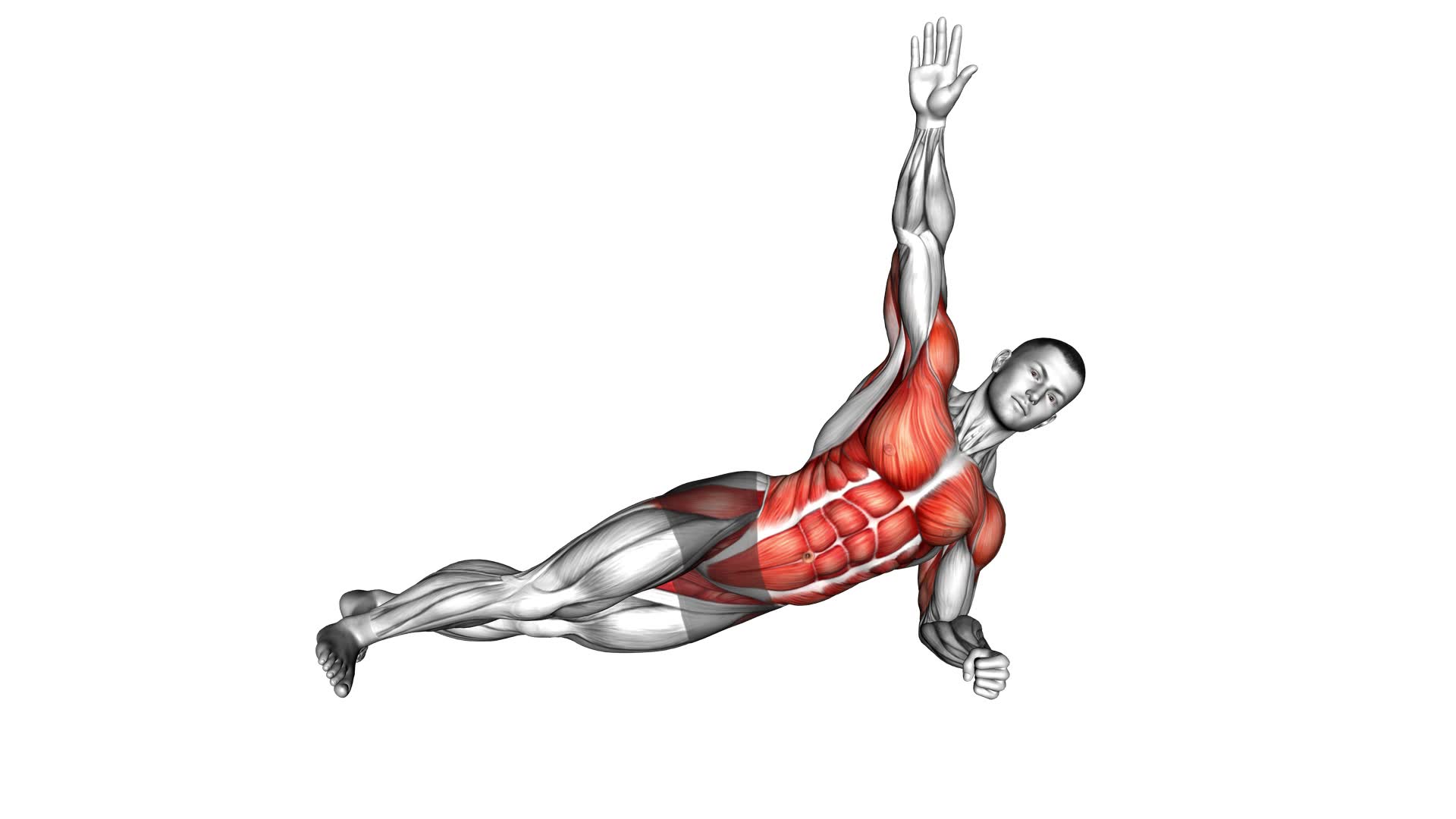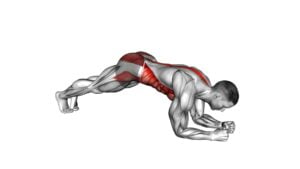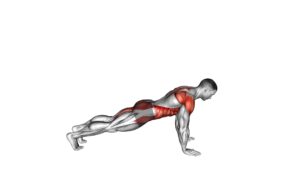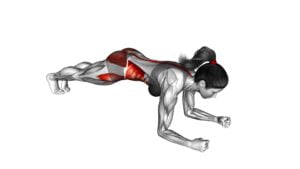Roll Press Plank (male) – Video Exercise Guide & Tips

Looking to strengthen your core and improve stability?
Watch This Exercise Video
The Roll Press Plank is the perfect exercise for you.
In this video exercise guide, you'll learn the benefits of this move, proper form and technique, variations for intermediate and advanced users, as well as common mistakes to avoid.
Plus, we'll provide tips for increasing difficulty and intensity.
Incorporate the Roll Press Plank into your workout routine and start seeing results.
Let's get started!
Key Takeaways
- The Roll Press Plank strengthens core muscles and improves stability.
- It targets the abdomen, lower back, and hips, enhancing posture and balance.
- Proper form and technique include maintaining a neutral neck and spine, avoiding arching or rounding of the back, and engaging the core and squeezing the glutes.
- Intermediate and advanced users can try variations like side plank with leg lift, plank with shoulder taps, and plank jacks to challenge themselves.
Benefits of the Roll Press Plank
The roll press plank provides numerous benefits for individuals looking to strengthen their core and improve overall stability. By engaging your core muscles, this exercise helps to increase core strength and stability. The roll press plank specifically targets the muscles in your abdomen, lower back, and hips, which are essential for maintaining proper posture and balance. This exercise also activates the deep stabilizing muscles in your core, which can help prevent injuries and improve athletic performance.
One of the key benefits of the roll press plank is its ability to improve core stability. As you hold the plank position and roll the exercise ball forward and backward, your core muscles are constantly engaged to maintain balance. This strengthens the muscles surrounding your spine and pelvis, providing a solid foundation for other movements and activities.
Additionally, the roll press plank helps to develop core strength. As you press the ball forward, you're working your abdominal muscles, specifically the rectus abdominis and obliques. This not only helps to sculpt your midsection but also improves your ability to generate power and transfer force between your upper and lower body.
To ensure you get the most out of this exercise, it's important to focus on proper form and technique.
Proper Form and Technique
To ensure you get the most out of the roll press plank exercise and maximize its benefits, it's important to focus on maintaining proper form and technique. Proper form is crucial for targeting the correct muscles and avoiding injury.
Start by positioning yourself in a high plank position with your hands directly under your shoulders and your body in a straight line from head to toe. Engage your core muscles by pulling your belly button towards your spine and squeezing your glutes. Keep your neck and spine neutral throughout the exercise. Avoid arching or rounding your back, as this can strain your lower back. Another common mistake is allowing your hips to sag or lift too high, which reduces the effectiveness of the exercise. Remember to breathe deeply and exhale as you roll the ball forward.
By maintaining proper form, you'll fully engage your core muscles and maximize the benefits of the roll press plank.
Now that you understand the importance of proper form and technique, let's explore some variations for intermediate and advanced users.
Variations for Intermediate and Advanced Users
Ready to take your plank routine to the next level? Challenge yourself with these advanced variations that will test your strength and stability.
Progressing your plank exercises can help you build a stronger core and improve overall body control.
Get ready to feel the burn with these advanced core strengthening exercises.
Challenging Plank Variations
Get ready to challenge yourself with these 5 intermediate and advanced variations of the plank exercise. Take your plank to the next level with these challenging modifications:
- Side Plank with Leg Lift: Start in a side plank position and lift your top leg up, engaging your core for stability.
- Plank with Shoulder Taps: While holding a plank, alternate tapping your opposite shoulder with your hand, focusing on keeping your hips stable.
- Plank Jacks: Begin in a traditional plank position and jump your feet out wide, then back together, mimicking a jumping jack motion.
These variations will push your core strength and stability to new heights. Incorporating these challenging plank modifications into your routine will help you strengthen your abs, back, and overall body stability.
Progressing Your Plank Routine
Now let's take your plank routine to the next level with these intermediate and advanced variations.
To continue progressing your plank, you can try different options to challenge yourself further.
One option is to increase the time and duration of your plank hold. Start by adding 10 seconds to your current plank time and gradually increase it over time.
Another progression option is to incorporate variations such as side planks or plank jacks. Side planks engage your obliques, while plank jacks add a dynamic element to your routine.
Additionally, you can try performing your plank with your feet elevated on a stability ball or a bench to further intensify the exercise.
Remember to maintain proper form and listen to your body as you progress.
Advanced Core Strengthening Exercises
To further challenge yourself and continue progressing your core strength, what advanced variations can you incorporate into your plank routine? Here are three advanced plank variations that can take your core strengthening to the next level:
- Side Plank with Leg Lift: From a side plank position, lift your top leg up while keeping your core engaged. This variation targets your obliques and hip muscles, adding an extra challenge to your plank routine.
- Plank with Arm Raise: Start in a standard plank position and lift one arm straight out in front of you while maintaining a stable core. This variation not only works your core but also engages your shoulders and upper back.
- Plank with Knee Tuck: Begin in a high plank position and bring one knee towards your chest, engaging your core as you do so. Alternate between legs for a challenging core and hip workout.
Incorporating these advanced plank variations into your routine can help you strengthen your core even further, leading to improved stability, better posture, and enhanced athletic performance.
Common Mistakes to Avoid
To perform the Roll Press Plank correctly and avoid common mistakes, it's important to pay attention to your form. Incorrect form can lead to dangers such as strain or injury.
Another common mistake to avoid is lack of core engagement, as this exercise is designed to target and strengthen your core muscles.
Lastly, be mindful of overarching or sagging, as this can compromise the effectiveness of the exercise and put unnecessary strain on your back.
Incorrect Form Dangers
Avoiding incorrect form dangers is crucial when performing the Roll Press Plank exercise. Proper technique is essential to prevent potential injuries and maximize the benefits of this exercise. Here are some common mistakes to avoid:
- Arching your back: This can strain your lower back and increase the risk of injury.
- Dropping your hips: This reduces the effectiveness of the exercise and shifts the focus away from your core.
- Holding your breath: Breathing is important to maintain stability and engage your core muscles properly.
Failing to maintain proper form can lead to various consequences, such as muscle imbalances, decreased stability, and increased risk of back pain.
Now, let's explore another important aspect of the Roll Press Plank exercise: the lack of core engagement.
Lack of Core Engagement
When you fail to engage your core properly during the Roll Press Plank exercise, it can hinder your progress and lead to ineffective results. Core activation is crucial in this exercise as it helps stabilize your body and maintain proper form.
One common mistake is allowing your hips to sag or your lower back to arch, which takes the focus away from your core. To avoid this, make sure to engage your abdominal muscles by pulling your belly button towards your spine and squeezing your glutes.
Additionally, you can modify the plank by performing it on your knees or using an exercise ball for added stability. These modifications can help you maintain core engagement and maximize the benefits of the Roll Press Plank exercise.
Overarching or Sagging
To prevent overarching or sagging during the Roll Press Plank exercise, focus on maintaining a straight line from your head to your heels. Proper form is crucial to getting the most out of this exercise and avoiding injury. Here are some important tips to keep in mind:
- Engage your core muscles throughout the exercise to help maintain stability and prevent overarching or sagging.
- Keep your hips level and avoid letting them drop or rise too high.
- Pay attention to your shoulder position; avoid rounding them forward or hunching your back.
Maintaining proper form throughout the Roll Press Plank won't only help you get the most out of this exercise but also protect your body from unnecessary strain and injury.
Tips for Increasing Difficulty and Intensity
To increase the difficulty and intensity of the Roll Press Plank exercise, you can try incorporating variations and challenges. This will help you progress in your fitness journey and continue to challenge your core muscles.
One way to increase difficulty is by extending the duration of the exercise. Instead of holding the plank position for the usual 30 seconds, try holding it for 45 seconds or even a minute. This won't only increase the intensity but also test your endurance.
Another variation you can try is the single-leg Roll Press Plank. Start in the regular plank position, and then lift one leg off the ground while maintaining a straight body line. This variation will engage your core and stability muscles even more.
Additionally, you can try adding a stability ball or a Bosu ball to the exercise. Placing your forearms or feet on the ball while performing the Roll Press Plank will challenge your balance and stability, making the exercise more intense.
Remember to gradually increase the difficulty and intensity of the exercise to avoid injury and ensure proper form.
Incorporating the Roll Press Plank Into Your Workout Routine
How can you effectively incorporate the Roll Press Plank into your workout routine? The Roll Press Plank is a challenging exercise that targets your core muscles and helps to improve strength and stability.
To incorporate this exercise into your routine, consider the following tips:
- Start with modifications: If you're new to the Roll Press Plank or have limited core strength, you can begin by performing the exercise with your knees on the ground instead of your toes. This modification will help you build up your strength gradually before progressing to the full version of the exercise.
- Add it to your core workout: The Roll Press Plank can be a great addition to your core workout routine. You can perform it after exercises like planks or crunches to further challenge your core muscles.
- Mix it up with advanced core exercises: Once you have mastered the Roll Press Plank, you can incorporate it into a circuit of advanced core exercises. Try combining it with exercises like mountain climbers, Russian twists, or bicycle crunches for a challenging and effective core workout.
Incorporating the Roll Press Plank into your workout routine can help you strengthen your core and improve your overall fitness. Remember to start with modifications if needed and gradually progress to more advanced variations of the exercise.
Frequently Asked Questions
How Long Should I Hold the Roll Press Plank Exercise?
To maximize the benefits of the roll press plank exercise, it's important to hold the position for an adequate amount of time. The ideal duration is around 30 seconds to 1 minute. This timeframe allows your core muscles to engage and strengthen effectively.
However, it's crucial to listen to your body and not push yourself too hard. Start with a shorter duration and gradually increase it as you build strength and endurance.
Remember to maintain proper form and avoid common mistakes to get the most out of this exercise.
Can the Roll Press Plank Help With Improving Core Strength?
The Roll Press Plank is a great exercise for improving core strength. It targets your abs and helps to stabilize your body.
By incorporating this exercise into your routine, you can strengthen your core muscles, which in turn can help with improving balance.
Additionally, there are variations of plank exercises that you can try to challenge yourself even further and continue to build your core strength.
Keep up the good work!
Is the Roll Press Plank Suitable for Beginners?
Yes, the roll press plank can be suitable for beginners. It's a challenging exercise that targets the core muscles.
To make it more accessible, you can try modifications such as performing the exercise on your knees or using an elevated surface for support.
Additionally, there are variations of the roll press plank that allow for progression as you build strength and stability.
Remember to focus on maintaining proper form and start with modifications that suit your fitness level.
Can the Roll Press Plank Be Beneficial for Individuals With Lower Back Pain?
The roll press plank can be beneficial for individuals with lower back pain. It helps to strengthen the core muscles and improve stability, which can alleviate discomfort in the lower back.
To prevent exacerbating the pain, it's important to maintain proper form and technique. Keep your back straight, engage your core, and avoid arching or rounding your spine.
Start with shorter holds and gradually increase the duration as your strength improves.
Are There Any Modifications or Alternatives to the Roll Press Plank for Those With Wrist or Shoulder Issues?
If you're dealing with wrist or shoulder issues, there are modifications and alternatives to the roll press plank. These modifications can help alleviate any discomfort or pain.
For instance, you can try doing a forearm plank instead of a full plank to put less strain on your wrists.
Another alternative is the bird dog exercise, which targets your core without putting pressure on your shoulders.
Remember to always listen to your body and adjust the exercises accordingly.
Conclusion
Incorporating the roll press plank into your workout routine can help improve core strength, stability, and overall fitness. By following proper form and technique, you can maximize the benefits of this exercise.
With variations for intermediate and advanced users, you can continually challenge yourself and increase the difficulty and intensity.
Avoiding common mistakes and incorporating tips for increasing difficulty will ensure you get the most out of this exercise.
Add the roll press plank to your routine for a challenging and effective workout.

Author
Years ago, the spark of my life’s passion ignited in my mind the moment I stepped into the local gym for the first time. The inaugural bead of perspiration, the initial endeavor, the very first surge of endorphins, and a sense of pride that washed over me post-workout marked the beginning of my deep-seated interest in strength sports, fitness, and sports nutrition. This very curiosity blossomed rapidly into a profound fascination, propelling me to earn a Master’s degree in Physical Education from the Academy of Physical Education in Krakow, followed by a Sports Manager diploma from the Jagiellonian University. My journey of growth led me to gain more specialized qualifications, such as being a certified personal trainer with a focus on sports dietetics, a lifeguard, and an instructor for wellness and corrective gymnastics. Theoretical knowledge paired seamlessly with practical experience, reinforcing my belief that the transformation of individuals under my guidance was also a reflection of my personal growth. This belief holds true even today. Each day, I strive to push the boundaries and explore new realms. These realms gently elevate me to greater heights. The unique combination of passion for my field and the continuous quest for growth fuels my drive to break new ground.







